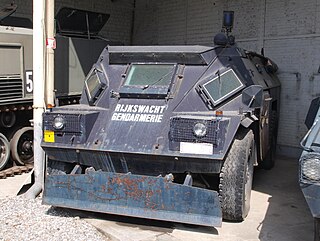
The Tank, Infantry, Mk IV (A22) Churchill was a British infantry tank used in the Second World War, best known for its heavy armour, large longitudinal chassis with all-around tracks with multiple bogies, its ability to climb steep slopes, and its use as the basis of many specialist vehicles. It was one of the heaviest Allied tanks of the war.

The Rolls-Royce armoured car is a British armoured car developed in 1914 and used during the First World War, Irish Civil War, the inter-war period in Imperial Air Control in Transjordan, Palestine and Mesopotamia, and in the early stages of the Second World War in the Middle East and North Africa.

The Humber armoured car was one of the most widely produced British armoured cars of the Second World War. It supplemented the Humber Light Reconnaissance Car and remained in service until the end of the war.

AEC armoured cars are a series of British heavy armoured cars built by the Associated Equipment Company (AEC) during the Second World War.

The Ferret armoured car, also commonly called the Ferret scout car, is a British armoured fighting vehicle designed and built for reconnaissance purposes. The Ferret was produced between 1952 and 1971 by the UK company Daimler. It was widely used by regiments in the British Army, as well as the RAF Regiment and Commonwealth countries throughout the period.

The M8 light armored car is a 6×6 armored car produced by the Ford Motor Company during World War II. It was used from 1943 by United States and British forces in Europe and the Pacific until the end of the war. The vehicle was widely exported and as of 2024 still remained in service with some countries.

The T17E1 armored car was an American armored car manufactured during the Second World War. It saw service with British and other Commonwealth forces during the war under the name Staghound, but was never used on the front line by US forces. A number of other countries used the Staghound after the war; some vehicles continued to serve until the 1980s.

The Marmon–Herrington armoured car was a series of armoured vehicles that were produced in South Africa and adopted by the British Army during World War II. They were also issued to RAF armoured car companies, which seem never to have used them in action, making greater use of Rolls-Royce armoured cars and other types.

Armoured Carrier, Wheeled, Indian Pattern (ACV-IP), known also as Indian Pattern Carrier or other similar names, was an armoured car produced in India during the Second World War. It was typically armed with a Bren light machine gun. Those produced by Tata Locomotives were called "Tatanagars" after the location of the works. 4,655 were produced, used by Indian units in the Far East and Mediterranean and Middle East Theatre, typically in divisional reconnaissance regiments.

The Humber Light Reconnaissance Car, also known as Humberette or Ironside, was a British armoured car produced during the Second World War.

Standard Car 4x2, or Car Armoured Light Standard, better known as the Beaverette, was a British improvised armoured car produced during the Second World War.

The Lanchester 6×4 armoured car was a British armoured car with a 6×4 drivetrain produced in limited numbers in the late 1920s and early 1930s. A heavier, more rugged development of the earlier Lanchester 4x2 armoured car, it remained in service with Territorial and colonial units until the early 1940s and saw action in the Battle of Malaya.

The Guy Armoured Car was a British armoured car produced in limited numbers during Second World War. The car saw limited action during the Battle of France.

Car, Armoured, Heavy (Aust), also known as Rhino, was an armoured car designed in Australia during the Second World War. Due to enemy action and design problems the project never got beyond a prototype stage.
A huge number of M113 armored personnel carrier variants have been created, ranging from infantry carriers to nuclear missile carriers. The M113 armored personnel carrier has become one of the most prolific armored vehicles of the second half of the 20th century, and continues to serve with armies around the world in many roles.

During the First World War, sixteen American Peerless trucks were modified by the British to serve as armoured cars. These were relatively primitive designs with open backs, armed with a Pom-pom gun and a machine gun, and were delivered to the British Army in 1915. They were used also by the Imperial Russian Army as self-propelled anti-aircraft guns.

Leyland Armoured Car refers to four armoured cars, built between 1934 and 1940, which were used by the Irish Army. The first Leyland Armoured Car was built in 1934, and three more were built by 1940. The Leylands served with the Irish Army until 1972, and with the reserve An Fórsa Cosanta Áitiúil (FCA) until the early 1980s.

Throughout its history, the Irish Army has used a number of armoured fighting vehicles.

The Timoney armoured personnel carrier refers to a series of armored personnel carriers developed by Timoney Technology Limited of Ireland in the 1970s and 1980s.


















